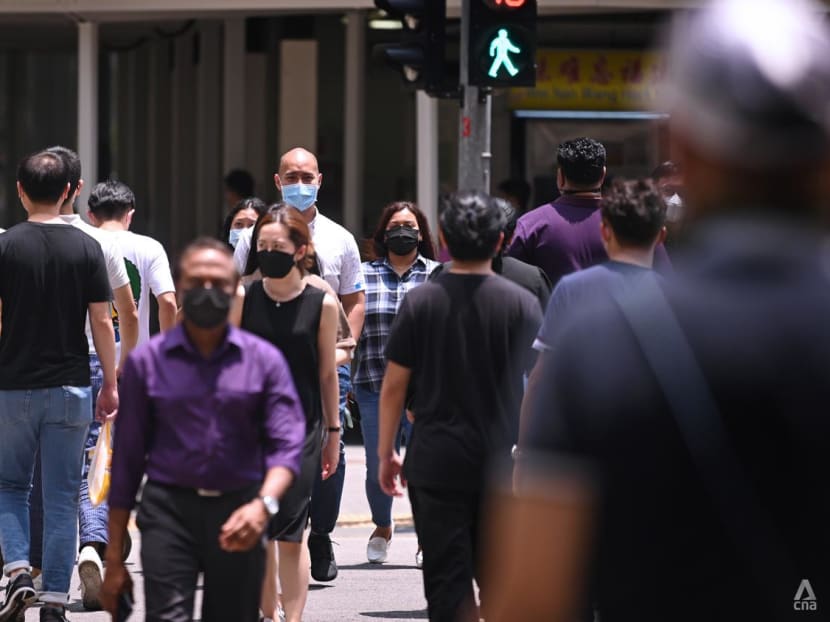CNA Explains: How dangerous are the BQ.1 and BQ.1.1 COVID-19 variants?
What are these new Omicron subvariants and could they cause another COVID-19 wave in Singapore?

People wearing protective face masks in the Central Business District in Singapore on Mar 25, 2022. (Photo: CNA/Gaya Chandramohan)
SINGAPORE: Singapore on Sunday (Oct 23) confirmed four cases of the BQ.1 and BQ.1.1 Omicron subvariants, all of which were imported infections.
The Ministry of Health (MOH) said it will closely monitor information about new strains, the prevalence of circulating variants in the local community and provide updates should there be significant developments.
Just how infectious are the new subvariants and should people be concerned? Here's what we know so far.
WHAT ARE THE BQ.1/BQ.1.1 VARIANTS?
First detected in Nigeria in July, the BQ.1 and BQ.1.1 subvariants are sub-lineages of the Omicron variant BA.5. The strains have since been detected in more than 50 countries.
The number of BQ.1/BQ.1.1 cases has recently been rising in parts of Europe and North America.
"Observations from those countries suggest that BQ.1/BQ.1.1 are possibly more transmissible than previous BA.5 sub-lineages, but there is currently no evidence that they cause more severe illness," Singapore's Health Ministry said on Oct 26.
BQ.1.1 has just one mutation more than BQ.1, which itself is only a few mutations away from BA.5.2, said Dr Sebastian Maurer-Stroh in response to queries from CNA.
The executive director at A*STAR’s Bioinformatics Institute said that BA.5.2 still dominates globally, but noted that BQ.1.1 now comprises 10 per cent of all sequenced samples in recent weeks and "has been rising accordingly".
Dr Anthony Fauci, director of the National Institute of Allergy and Infectious Diseases, also weighed in on the BQ.1 and BQ.1.1 variants, telling CBS News that the two strains have dangerous "qualities or characteristics" that could evade some of the current interventions.
HOW TRANSMISSIBLE ARE BQ.1 AND BQ.1.1?
BQ.1 and BQ.1.1 have spread quickly in the United States in the last few weeks, particularly in New York.
Last week, the US Centers for Disease Control and Prevention (CDC) estimated that both variants made up more than 16 per cent of the total circulating coronavirus variants in the United States.
The BQ.1 variant had previously made up only 5.8 per cent of circulating variants, while BQ.1.1 had made up 3.6 per cent of all variants, said the CDC.
Dr Fauci said that BQ.1.1 variant is particularly adept at dodging the protective antibodies from prior infection or vaccination.
"These variants (BQ.1 and BQ.1.1) can quite possibly lead to a very bad surge of illness this winter in the US as it's already starting to happen in Europe and the UK," said Gregory Poland, a virologist and vaccine researcher at Mayo Clinic.
The European Centre for Disease Prevention and Control warned that the two variants are likely to drive up cases in the coming weeks to months in Europe. It also said that it expected the two variants to account for more than half the infections in Europe between mid-November and early December.
Dr Maria Van Kerkhove, an infectious disease specialist who serves as the technical lead for COVID-19 response at the World Health Organization said in a video posted on Twitter that "at the present time there are more than 300 sublineages of Omicron that WHO and (its) partners are tracking worldwide."
"All of the subvariants of Omicron are showing increased transmissibility and properties of immune escape," she said
Dr Van Kerkhove added that none of these subvariants are dominant and that there have been no change in severity in the BQ.1.1 and BQ.1 variants.
She however added that "it's very early and we have very limited data to assess this".
WILL BQ.1/BQ.1.1 CAUSE A COVID-19 WAVE IN SINGAPORE?
Dr Maurer-Stroh said he expects to see more BQ.1.1 infections globally in the coming weeks.
However, he added: "This may be less pronounced in Singapore since we just had a wave here and the levels of immunity in the population are higher."
The BQ.1.1 variant is just one of several lineages currently circulating that has a new spike surface pattern compared to earlier versions, he said, adding that this makes it easier for these variants to infect and reinfect people.
Still, it is likely not more virulent as its rise can be explained by better ability to evade immune responses, said Dr Maurer-Stroh.
Dr Van Kerkhove said that countries need to be prepared and they need to be in a position to conduct surveillance, deal with increases in cases and perhaps deal with an increase in hospitalisations.
ARE CURRENT VACCINE RECOMMENDATIONS ENOUGH?
Yes, the recommendation for timely boosters would help prolong protective immunity, said Professor Lisa Ng, executive director at A*STAR's infectious diseases labs.
Dr Fauci said that it is "somewhat encouraging news" that both strains are sub-lineages of the BA.5 variant, so "there are almost certainly going to be some cross-protection that you can boost up".
Meanwhile, Dr Van Kerkhove also said that the current vaccines are effective.
"We (WHO) don't see a change in severity yet and our vaccines remain effective, but we have to remain vigilant," she said.
MOH previously said the current mRNA vaccines will be replaced by bivalent vaccines, as recommended by the expert committee on COVID-19 vaccination.
“The bivalent Moderna/Spikevax vaccine is based on the same original vaccine, with the same dosage for boosting,” it said.
The bivalent shots will be more effective than the original vaccine in triggering an immune response against newer COVID-19 variants, said Prof Ng.
MOH also said that those aged 50 and above should also receive an additional booster dose between five months and one year from their last dose, to keep up to date with their COVID-19 vaccination.
You may also be interested in:
BOOKMARK THIS: Our comprehensive coverage of the COVID-19 pandemic and its developments
Download our app or subscribe to our Telegram channel for the latest updates on the coronavirus pandemic: https://cna.asia/telegram










